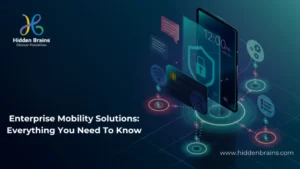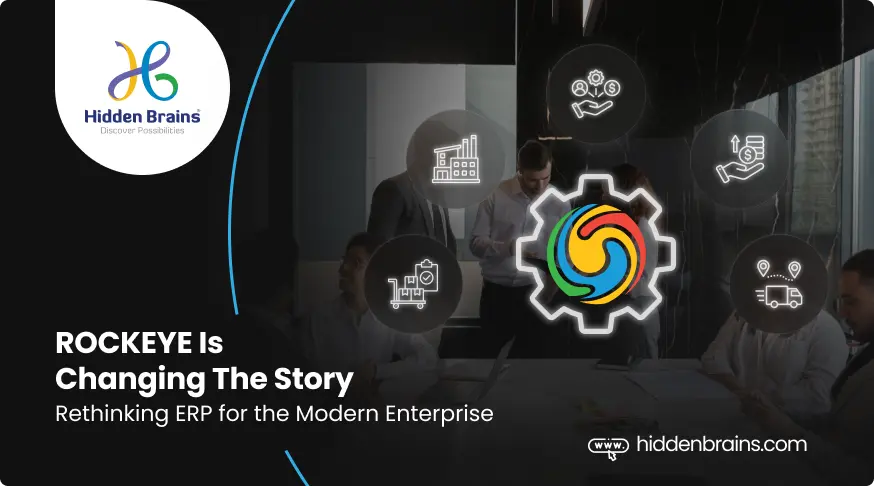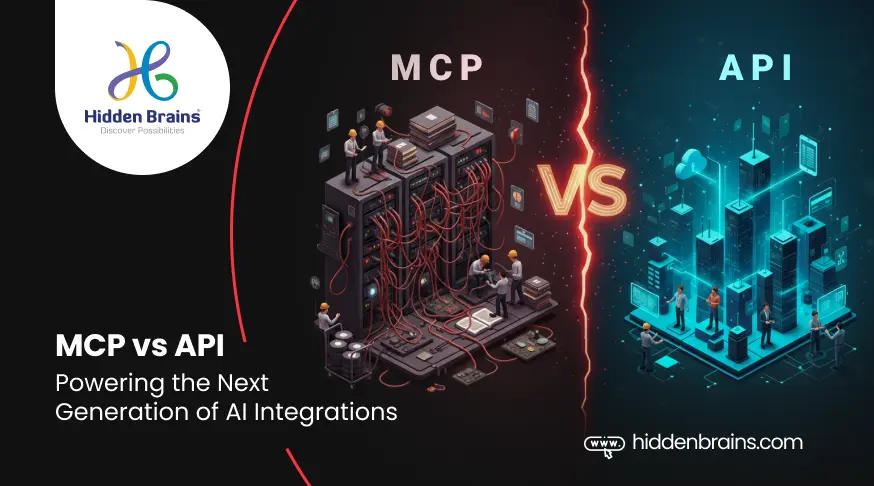Are you looking to capitalize on your business growth and efficiency with Enterprise Mobility Solutions? But don’t know where to begin and what it holds?
This blog is for you. Here, we will discover every edge of Enterprise Mobility Solutions and the convenience it brings to businesses.
Enterprise Mobility Solutions is the modern advancement in the business world and has the potential to automate most of the business operations. It is a step towards digital transformation and bringing everything at a click.
As the business stage is getting more reliable in a digitally connected world, investing in Enterprise Mobility Solutions is heating up the competition and allowing businesses to stand out efficiently and conveniently. According to reports, the global enterprise mobility solutions market is set to generate $151 billion by 2027.
With Enterprise Mobility Solutions, businesses bring out the best in products and services, allowing customers to access them from the comfort of their homes.
Looking to revolutionize your business with a mobile app? Hire top mobile app developer for cutting-edge Enterprise Mobility Solutions!
This gives you better growth opportunities and a loyal customer base counting on you. Enterprise Mobility Solutions is paving the way to set a standard of convenience and shaping growth for businesses.
Let’s watch the quick video to know “A Complete Guide to Enterprise Mobility Solutions”
A Complete Guide to Enterprise Mobility Solutions
About Enterprise Mobility Solutions
An enterprise mobility solution is a mobile solution deployed across an organization. Using mobile technology, it connects people, processes, and data. Mobility enterprise solutions allow consumers to interact more efficiently with the products and services of an organization.
The introduction of Enterprise Mobility Solutions (EMS) revolutionized how large organizations work. They make complicated processes simpler by connecting every aspect of business operations. There are several important ways in which EMS can transform business growth:
- Satisfaction of Customers: EMS makes customer service easier and faster so businesses can keep customers satisfied.
- Increased Security: Business data is critical and needs to be protected. The EMS is equipped with strong security features designed to keep hackers out.
- Reduction of Operational Costs: Employees can work from home with EMS, reducing office costs and saving businesses money. Additionally, instant access to data reduces transportation and administrative costs.
- Integration is easy: Businesses can easily integrate EMS with their existing systems, ensuring smooth operation.

Our Enterprise Mobility Solution can empower your workforce!
Latest Statistics Driving The Significance Of Enterprise Mobility Solutions
Enterprise mobility management solutions include both managing mobile devices and integrating services more rapidly. Using this concept, you can engage customers powerfully while enhancing employee productivity.
Here are some fascinating Statistics:
- The market for enterprise mobility is predicted to reach $63 billion by 2026,
- More than 47% of companies say enterprise mobility solutions is important.
Most Popular Types Of Enterprise Mobility Solutions
There are various types of Enterprise Mobility Solutions setting an example of game-changing digital transformation.
Here are some of the most popular types of Enterprise Mobility Solutions leading the change:
1. Mobile Device Management (MDM)
MDM, or Mobile Device Management, involves managing mobile devices of all types, including laptops and tablets. It is designed to enable organizations to overcome challenges when implementing business enterprise mobility by providing a single location for managing all mobile devices.
2. Mobile Application Management [MAM]
A mobile application management system – or MAM – manages enterprise mobile applications, both commercially available and internally developed applications. Applications like these are essential to implementing enterprise mobility seamlessly. As a result, enterprises can boost application security by providing control at the application level.
3. Identity Management

To manage enterprise mobility, various approaches to identity management are used. Among them are:
- Code signatures for apps
- Certification of devices
- Validation
- Login with a single click
This way, users and devices can only access corporate data, applications, and processes. Identity management is concerned with creating departmental credentials to ensure that all team members have access to the same applications and information.
4. Content Management
Content management on mobile devices is similar to information management. The content management process focuses more on content access than database access.
Content management focuses on:
- Access to content
- Pushing content
- Security of content
The majority of content management solutions provide organizations with the opportunity to configure their authentication policies. Similarly, content management can also be included in application and device management.
It could be effective for some organizations just to use a content management system. To maximize your enterprise mobility solution, it is time to turn to the top Mobile App Development Company.
5. Mobile Email Management
MEM or Mobile Email Management enables businesses to keep their cybersecurity strong and maintain effective security measures to protect against hacks and breaches.
Corporation administrators can determine which units can access emails, ensure that sensitive and confidential information is encrypted, allow resources to synchronize their emails using any device and network, and decide who can access them.
Read More: Top Mobile App Development Ideas in 2024
Top Practices To Develop Best Enterprise Mobility Solutions
Developing world-class enterprise mobility solutions demands best practices. Here is the list of best practices to develop enterprise mobility solutions.
1. Establish Business Goals
To implement an effective strategy, an organization should understand and identify how it will affect its operations. Defining goals that align with the enterprise’s core goals is crucial for achieving the desired results. It is essential to carefully consider your business goals and how mobile can help you achieve them.
Identifying the purpose of enterprise mobility is critical. Analyze your organization for mobile opportunities. To determine your business needs, you can use key performance indicators (KPIs), customer feedback, and industry trends.
Make sure the mobility solutions you choose are part of your overall digital strategy. A successful enterprise mobile strategy requires identifying business needs.
2. Conduct Competitive Research

After identifying your goals, it is time to look at your competitors!
Keep a clear eye on your competitors and take a step to stand out with the game-changing solutions. The competitors you choose for your business should be based on your objectives and the current market trends. It is best to select the top competitors from your industry to cover all your bases.
To refine your enterprise mobility strategy, analyze your competitive landscape and answer the questions below.
- Are there any business problems this app can solve or value it will add?
- What actions will you take to address app users’ feedback about your competitors’ apps?
- Which business processes will be affected by new mobile apps?
- How reliable is your business’s technology infrastructure for building and supporting mobile apps?
- What are your competitors doing to market their apps?
- Make a spreadsheet to analyze your competitors and document your research. Taking this step will assist you in moving forward with your mobility strategy.
Many of your competitors do not have apps, which gives you an excellent opportunity to lead your industry.
3. Create a Strategic Plan with Goals and Objectives
As soon as you have identified your needs. The next step is identifying your goals and objectives and prioritizing your needs.
Here are some important questions to ask:
- What are the apps that are going to have the biggest impact on your employees, customers, and business?
- Are you ready to support this app in your business?
- How can mobility help your business deliver the solutions it needs?
- It is important that your long-term implementation objectives focus on the usage and scalability of your application. Besides the daily usage, you will gather an unlimited amount of information.
By defining your goals and objectives in advance, you can measure success metrics more accurately.

Looking to Boost Security?
4. Select The Right Mobile Platform And Experience
Enterprise mobile initiatives are divided into Native Mobile Apps and Cross-Platform Apps. A native mobile app performs well and provides the best user experience. Native apps will allow you to provide your users with a higher-quality experience.
Various cross-platform mobile frameworks are available, including Xamarin, React Native, and Flutter. HTML5 and JavaScript are common web technologies used for cross-platform apps. Native apps run inside a container.
An appropriate mobile platform can be chosen and developed based on factors such as the end-user, the device to use, and the required features. Hire app developers and they will help you with best possible development.
5. Continual Application Delivery
Enterprises must invest in continuous innovation and deliver frequent revisions to their mobile products. Due to the regular updates of mobile apps, enterprises should go beyond traditional methodologies and consider Agile approaches.
Enterprises should adopt Agile methods in software development to continuously improve the mobile product based on user feedback and data. Enterprises must continue to support mobile apps as bugs, new features, and security vulnerabilities emerge.
Read more: Top Mobile App Development Trends in 2024
6. Security Approach
With enterprise mobility, anyone with the right access to data can access it anytime, anywhere. Defining the identity of the user and implementing security-based protocols for security verification. API use is increasing exponentially, so securing backend integration and transaction details is a significant concern.
Developing apps and ensuring security is critical to implementing a successful mobility strategy. When encouraging BYOD, corporate data should be remotely wiped if a device is lost or malfunctions.
Leading Enterprise Mobility Solutions Trends For Businesses

Dive into the pulse of business evolution as we uncover the latest trends in Enterprise Mobility Solutions, guiding businesses towards a tech-savvy landscape in 2025 and beyond.
1. Augmented And Virtual Reality
Virtual reality (VR) and augmented reality (AR) applications have become necessities for the enterprise. Keeping up with the latest AR/VR trends can help associations gain better results with enterprise mobility. The innovation’s adoption will increase, so workers will expect more projects to integrate it.
2. Cloud Technologies
The trend toward cloud-based applications also increases as endeavors move to the cloud. To stay on top of the latest cloud computing trends, enterprises use different platforms from leading vendors.
3. Artificial Intelligence and Machine Learning
With innovation moving toward better business management, organizations are investing in AI application development. Adding this innovation to enterprise development solutions in the future will provide a more personalized experience for users. Chatbots and language development are common features of AI-powered apps.
4. IoT
Internet of Things technologies, including mobile apps, affect business operations across the enterprise. Designers in various industries regularly use IoT-enabled applications in their work environment.
Recently, IoT has positively impacted mobile app development. It enables enterprises to manage their business remotely via various smart devices.

Want to Enhance Connectivity?
Build seamless collaboration and communication within your organization by leveraging our enterprise mobility solutions!How Much Does It Cost To Develop Enterprise Mobility Solutions?
A range of factors can affect the cost of developing enterprise mobility solutions. An application that includes only the most basic features costs $12,000* to $15,000*+, while the medium version can cost between $15,000* to $18,000*+ and the advanced version might cross $25,000*+.
To develop top-notch enterprise mobility solutions, it is ideal to hire mobile app developers.
Many factors contribute to the overall cost of developing enterprise mobility solutions. Here are some key factors that impact the costs of developing such solutions.
Conclusion: How Do Hidden Brains Help You Get Started With the Solution?
Enterprise Mobility Solutions transforms the future of business and allows them to make the most of advanced technology to lock in growth and repeat customers. But to discover the true potential of Enterprise Mobility Solutions, you need to follow the best practices and bring your development idea to life
If you fail to develop Enterprise Mobility Solutions, Hidden Brains has a dedicated team of developers and experts to put your enterprise mobility solutions idea to life.
As a top software development company, Hidden Brains continues to develop top-notch applications with the approach to shape business growth and bring in efficiency. Our dedicated team of developers walks the extra mile with you to deliver the best solutions for trendsetting growth.
Contact us today and develop impact enterprise mobility solutions that make your business operations convenient.
FAQs
Unlock the key insights and answers you need in our FAQs, delving into the cutting-edge landscape of Enterprise Mobility Solutions for 2024, ensuring your business stays ahead in the digital transformation journey.
How Does an Enterprise Mobility Strategy Work?
The enterprise mobility strategy combines mobile devices and technologies to boost productivity within an organization. With this approach, users can access business data and applications from anywhere and at any time.
Essentially, seamless communication and collaboration are dependent on policies, technology, and management. With enterprise mobility solutions, organizations can streamline workflows, improve decision-making processes, and increase productivity.
How Much do Enterprise Mobility Solutions Cost?
Costs vary according to the scope of the project, ranging from basic to comprehensive features. Costs are also affected by the platform selection (iOS, Android, or cross-platform) and the complexity of the design. Budgets are significantly impacted by security measures, integration with existing systems, and testing requirements.
What is the Role of Enterprise Mobility Solutions for Business Growth?
Increasing efficiency and connectivity with Enterprise Mobility Solutions fosters business growth. Employees gain remote access to crucial data and applications using these solutions, enabling them to be more productive and flexible.
Decisions are made faster when collaboration and workflows are streamlined in real time. Furthermore, mobile interfaces boost customer engagement, ultimately resulting in higher revenue. Businesses must embrace mobile-driven environments to stay competitive and grow sustainably.
Should Businesses Develop Enterprise Mobility Solutions?
Developing enterprise mobility solutions is crucial to staying competitive and fostering business growth. Data access, workflow efficiency, and communication are all enhanced with these solutions, resulting in higher efficiency and productivity.
With the rising mobility of the workforce, employees and customers require a robust mobile solution. A well-designed and secure enterprise mobility solution can improve customer satisfaction, greater agility, and operational efficiency.






























































































![Sales & Distribution [Oil & Gas] Sales & Distribution [Oil & Gas]](https://www.hiddenbrains.com/blog/wp-content/themes/blankslate/assets/images/sales_and_distribution-icon.74d08193.svg)

![Fluid Terminal Management [Oil & Gas] Fluid Terminal Management [Oil & Gas]](https://www.hiddenbrains.com/blog/wp-content/themes/blankslate/assets/images/fluid_terminal_management-icon.4b3a27a4.svg)































![Sales & Distribution [Oil & Gas] Sales & Distribution [Oil & Gas]](https://www.hiddenbrains.com/blog/wp-content/themes/blankslate/assets/images/sales_and_distribution-icon.74d08193.svg?1.0.0)
![Fluid Terminal Management [Oil & Gas] Fluid Terminal Management [Oil & Gas]](https://www.hiddenbrains.com/blog/wp-content/themes/blankslate/assets/images/fluid_terminal_management-icon.4b3a27a4.svg?1.0.0)
























































































































































































